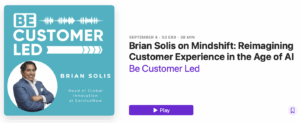Disruptive technology is not just a commodity anymore; it has become a necessity.
I recently met with Rilke Thomsen of Sleeknote to talk about how disruptive technology is shaping customer behaviors, preferences and expectations. Our conversation turned into a short but interesting three-part audio series that I wanted to share with you here.
What is disruptive technology?
Disruptive technology is something that comes along early on and has the potential to disrupt markets, behavior, and processes models. According to Brian, there are three concepts of disruptive technology, and they are…
Iteration: doing the same things better
Innovation: doing new things that create new value
Disruption: doing new things that make the old things obsolete
Disruptive technology – a commodity or a necessity?
Brian suggests that we take the “e” out of e-commerce and just look at commerce. Whether it’s digital, mobile or social, disruption can, for instance, be found in the transaction space, in the form of money (bitcoin) or on the transaction platforms that we use. Take for example PayPal and Apple Pay.
These two technologies are not only teaching people that the idea of a digital wallet is possible but also that it’s necessary.
As a result, it starts to push people away from traditional transactional restraints. Brian sees great disruption happening on all levels of transactions, whether it’s on the business level, in whoever is conducting the transaction or hosting the transaction, or on the payment level.
From a consumer perspective, Brian recognizes that things such as artificial intelligence will come to play a much bigger role in helping people find what they’re looking for and make the whole buying process much easier and more efficient.
Part 1:
On-demand economy and accidental narcissists
Brian says that today’s consumers are part of the accidental narcissist, which contributes to what he calls the ego-system. It’s a market of people who, based on the use of apps like Uber, Tinder, PostMates, etc., are starting to learn that the world revolves around them.
As a result, they start to see the rest of the world in the same way as they see their favorite apps and wonder why they’re not able to do things this way; why everything isn’t that easy; and why everything isn’t that personal.
These attitudes create friction in traditional customer experiences and traditional e-commerce experiences. Over time, this friction opens the door for innovation and disruption from companies that recognize friction and seek to solve it.
As a result, you have these accidental narcissists who want what they want right now, and the services such as Uber, Tinder, PostMates, etc., are all designed to give you what you want at the moment you want it.
Part 2:
Can traditional e-commerce sites fight on-demand economy?
It’s all about perspective, says Brian. The challenge for ecommerce is that it continues to iterate, meaning they build upon a legacy foundation. That legacy foundation is driven by legacy perspectives of how they see the customers and the customers’ shopping preferences.
They don’t recognize this market of accidental narcissists, the on-demand economy, mobile-first or mobile-only behavior. These are very significant trends that require innovation — not iteration — which starts with perspective.
People who run ecommerce programs are stuck in the old way of seeing things, and they’re stuck in an organization that doesn’t necessarily support innovation.
Cultures are typically risk-averse, which is why startups are coming out of nowhere and can gain fraction because large organizations can’t do anything about it quickly.
Part3:
Thank you Sleeknote!
Brian Solis is principal analyst and futurist at Altimeter, a Prophet company, world renowned keynote speaker, and 7x best-selling author. His latest book, X: Where Business Meets Design, explores the future of brand and customer engagement through experience design. Follow him on Twitter and LinkedIn. Invite him to speak at your next event.






Leave a Reply